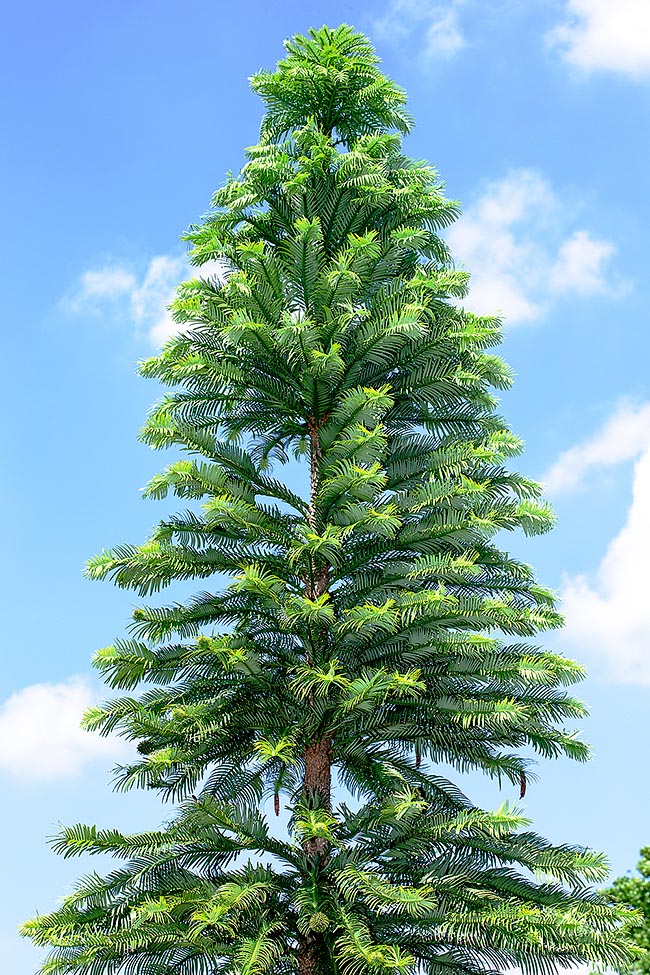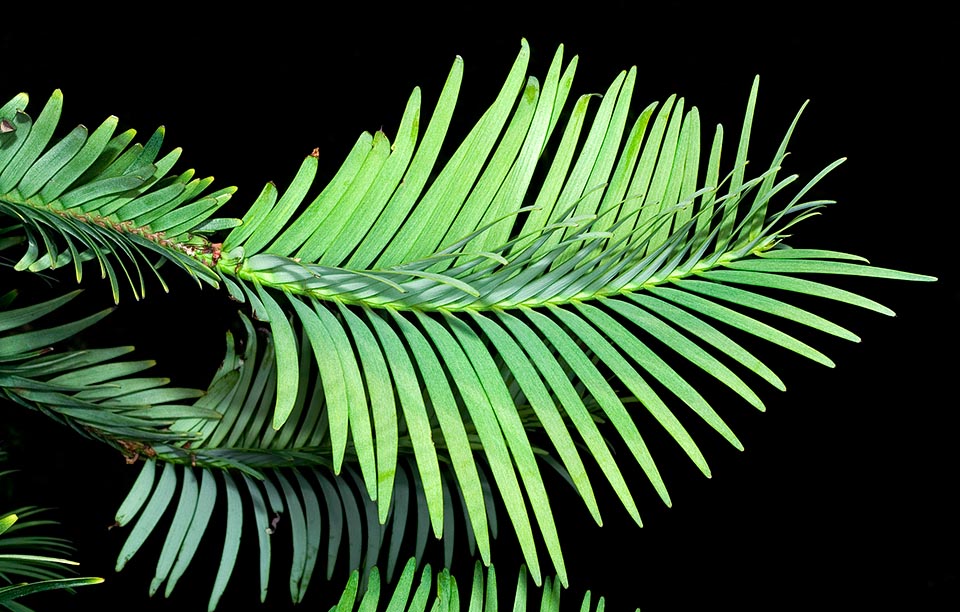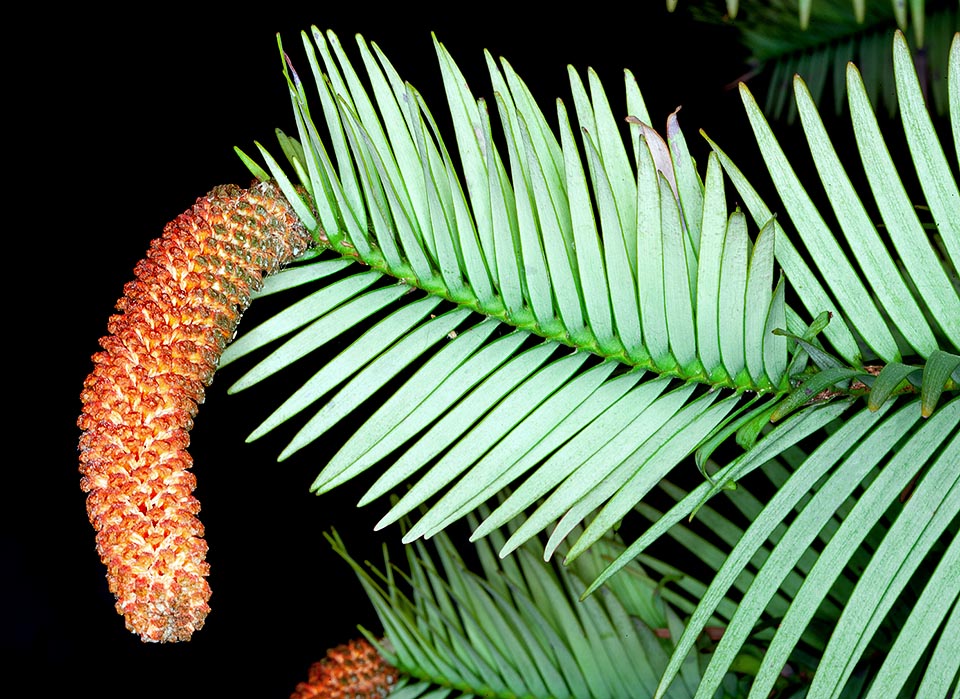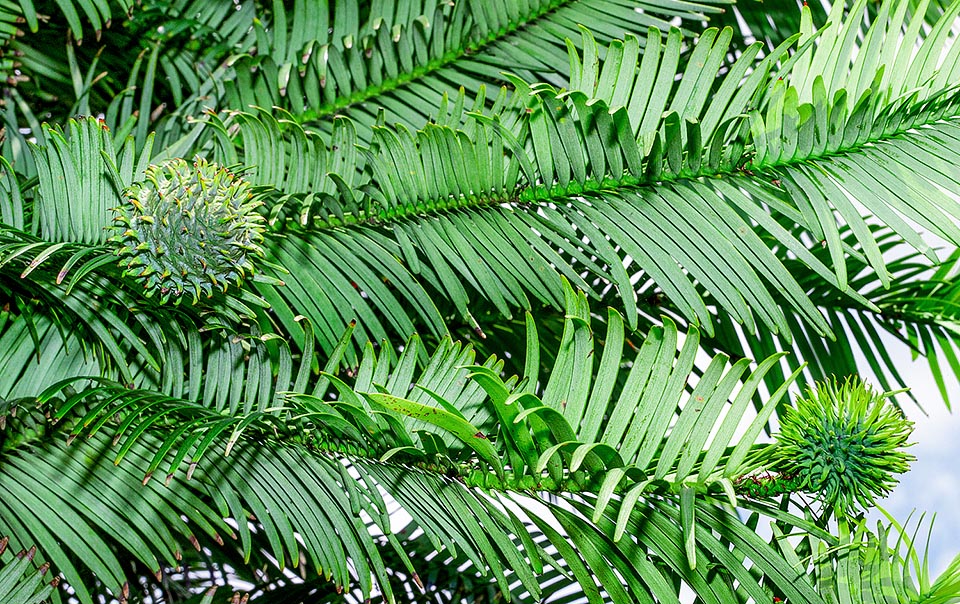Family : Araucariaceae

Text © Pietro Puccio

English translation by Mario Beltramini

The Wollemia nobilis is a “living fossil” discovered in Australia by the forester David Noble in 1994 © Giuseppe Mazza
The species is native to New South Wales, Australia, where is present, with a limited number of specimens, in a confined remote area of the Wollemi National Park, located in the central-eastern zone of the State. The tree grows on steep walls at the bottom of narrow deep valleys on rocky soils, poor, covered by a thin layer of humus, at an altitude of about 900 m above the sea level.
The name of the genus refers to the place of origin, the Wollemi National Park, from the aboriginal term “wollumi” = look around; the name of the species, the Latin adjective “nobilis, e” = noble, refers to the look of the tree, but deliberately alludes also to the name of its discoverer, the forester David Noble. Common names: dinosaur tree, living fossil, wollemi pine (English).
The Wollemia nobilis W.G.Jones, K.D.Hill & J.M.Allen (1995) is an evergreen, monoecious erect tree, with cylindrical trunk, 25-40 m tall and of more than 1 m of diameter, having wrinkled bark that flakes off in thin dark brown scales in the young plants, thickly covered by spongy tubercles, about 1,5 cm long and 1 cm broad, in the adult ones.
The plant has the unusual capacity of producing new trunks in proximity to the base for a sort of self coppicing.
The sessile leaves, present three different forms: triangular with acute apex, spirally arranged, 0,5-1 cm long and about 0,4 cm, in vertical buds that will originate the lateral branches.
In the young branches they are opposite or subopposite, decurrent (the foliar lamina extends at the base along the branch), oblong-linear, with rounded or obtuse apex, rigid, flat, 4-8 cm long and about 0,4 cm broad, of intense green colour above and covered by pruina below.
In the branches of the adult plants, initially ascending, then horizontal and finally drooping, the leaves are arranged in 4 rows, opposite or subopposite, decurrent, oblong-linear, with rounded apex, of dark green colour, up to about 10 cm of length and 0,8 cm of breadth.
The leaves do not dry and don’t fall singularly, but the whole branch detaches.
Terminal male cones on the lateral branches of both young and adult plants; cylindrical; 6-15 cm long and of 1-2 cm of diameter, with more than 500 scales with 4-9 pollen sacs in the lower surface.

Its characteristic sessile leaves were already known in the fossils, but nobody would have never imagined to find in a remote valley of New South Wales about one hundred of still living plants. Trees 25-40 m tall and of more than 1 m of diameter with the trunk thickly covered by spongy tubercles 1 cm broad and 1,5 cm long © Giuseppe Mazza
Terminal female cones on the lateral branches of adult plants, ellipsoid, 8-12 cm long and of 7-10 cm of diameter, with 300 fertile scales, 1,7 cm long, 2,2 cm broad and of 0,3-0,5 cm of thickness, with one ovule in the upper surface; the cones ripe in 18-20 months. The female cones usually are produced in the upper part of the tree. Seeds, 0,9-1,1 cm long, 0,7-0,8 cm broad, and of about 0,2 of thickness, surrounded by a wing 1-2 mm broad, of brown colour.
It reproduces by seed, placed superficially in particularly draining acidic organic loam maintained humid at the temperature of 26-28 °C, with germination times starting from 3-4 weeks and first fructification from the 7th year of age; it propagates easily also by tip and lateral cutting and by micropropagation.

The male cones of Wollemia nobilis present on young plants as well as in the adult ones, grow pendulous at the apex of the lateral branches. Cylindrical, reddish, even a pair of centimetres broad, they may reach 15 cm of length with more than 500 scales that rise when ripe evidencing, on the lower surface, 4 to 9 pollen sacs © Giuseppe Mazza
Of remarkable ornamental effect, fast growth and easy cultivation, it prefers warm temperate climates moderately humid, with highest temperatures not exceeding 36-38 °C and lowest ones little under the 0 °C, even if already from the first tests, on plants introduced in cultivation after its discovery, it has resulted that it can survive up to temperatures around the -10 °C. It bears full sun, except during the first years of growth when it needs a partial shade, but not the strong winds. It requires perfectly draining soils, acidic (in nature the pH of the soil is around 4), rich of organic substance for an optimal growth, maintained humid, but without stagnations.
Known through fossile finds discovered in Australia, New Zealand and Antarctica dating back to 200 million of years ago, its casual finding in a remote and inaccessible zone of Australia has been one of the most exceptional discovery of the XX century, that has aroused great interest and curiosity as much in the general public, thanks to the media that have reported the news with wide prominence.

The female cones, equally terminal, grow only on the lateral branches of the adult plants. They are ellipsoid, 8-12 cm long, with 300 fertile scales that carry one ovule in the upper part and take 18-20 months to ripe. Nowadays frequent in cultivation, the Wollemia nobilis is threatened in its valley by pathogens introduced by the man © G. Mazza
The local authorities have begun numerous measures for its preservation, from the secret on the exact locality, to the access limited to a restricted number of researchers with stringent phytosanitary precautions, with the purpose to avoid the introduction of disease and exotic plants. Furthermore, after the first distribution of seeds to gardens and botanical institutions, it has been started the regulated marketing of seeds of young plants obtained by vegetative way, in order to discourage the illegal collection and to finance the conservation projects.
Due to the limited number of individuals, concentrated in a restricted area, and the presence of dangerous pathogens (Phytophthora cinnamomi and Phytophthora multivora) introduced by the first visitors, probably through the soles of shoes, the species has been inserted in the red list of the IUCN (International Union for the Conservation of Nature and Natural Resources) as “Critically Endangered (at extremely high risk of extinction in nature in the immediate future).
→ To appreciate the biodiversity within the ARAUCARIACEAE family please click here.
